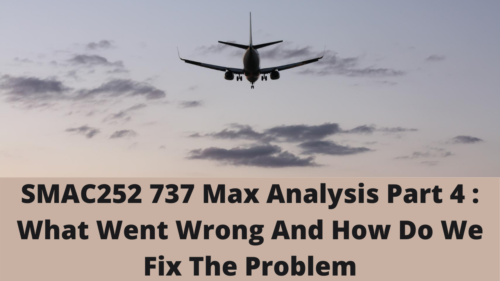Podcast: Play in new window | Download Subscribe: RSS

737 Max Analysis Part 4: What Went Wrong And How Do We Fix The Problem. Welcome to the show about learning to fly, living to fly, and loving to fly. Today we start a special series on 737 Max Analysis. Although a general aviation podcast we feel this is an important topic which all aviators can learn valuable lessons from. Joining me today is Ben Bohlman and Justin Ash.
Before we begin a quick word from our sponsor.
Preflight Checklist:
Sponsor: Aviation Careers Podcast. Use the coupon code PayItForward and you may receive a year access to the scholarships guide. Quantities limited.
The most recent update includes 52 new scholarships, 50 updates, and a new “Scholarships for Adults” category.
News And Announcements:
Cruise Flight (Talking Points):
So what went wrong?
- AOA DISAGREE indications were mistakenly mis-packaged
- Subcontracting issues with AOA DISAGREE, which was required for certification
- Certification being done in house, SME in house, or FAA better? Staffing issues in FAA, IP, and SME issues with FAA.
- Problems with repair procedures because of the subcontracting supply chain
- Fixation on IAS DISAGREE because AOA issues affect airspeed and altitude, leads to Crew Issues
Crew Issues
- First and foremost, training issues
- Is an iPad appropriate? Should there have been simulator training?
- Discussing with maintenance before writing up, led to fixation
- FO on 610 had numerous training issues associated with hand-flying the aircraft and identifying correct Non-Normal Checklists during abnormal or emergency situations.
- CA on 610 had numerous training issues associated with CRM and teamwork during abnormal or emergency situations
- CA on 302 was “new” as a captain and coming back to the 73 after years on widebodies. FO on 302 had only 300ish hours with almost 200 on the 73.
- All crew members started as airline pilots, no real GA, or other experience beforehand.
- Leads to overreliance on automation.
Checklist Issues
- Only two power settings are given for unreliable airspeed in the QRH, neither of which gives an approximate speed. In order to get any speeds, you must go to the Performance Inflight section of the QRH. Personal experience with this, it’s very cumbersome to switch between pages especially during a dynamic and time-critical emergency. It’s even cumbersome to have to switch between pages in the accident report itself; imagine the stress during an actual emergency.
- Lion Air QRH provides a checklist for AOA DISAGREE, which you’ll remember is an alert that cannot be displayed unless a further option is purchased (at the time)
- Airspeed Unreliable parameters wouldn’t have been met on 610 due to only being 15 knots (minimum 20 to be considered unreliable).
- 610 could not have continued the reading of the checklist anyway, due to the requirement of the aircraft being “trimmed and in stable flight”. That alone should have driven them to the runaway checklist.
So what is the fix?
- Of course, fixes haven’t been made public yet, but:
- Increased input requirements for MCAS
- Discussions include setting limits on number of activations
- What about all the issues that have been in the media about other things on the MAX needing fixing?
- Increased scrutiny due to public interest and FAA debate
- Minor issues common during first few years after aircraft certification (787, 727, etc)
- What about the crew factors involved?
- Simulator training with emphasis on hand flying
- Simulator training on specific MCAS scenarios/trim scenarios
- Number of simulators in the world a factor for new aircraft
After Landing Checklist:
Links Mentioned In This Podcast:
